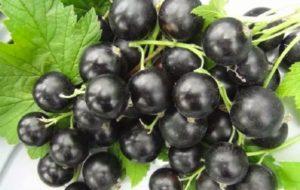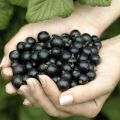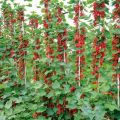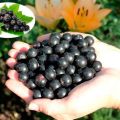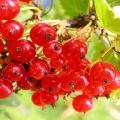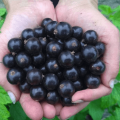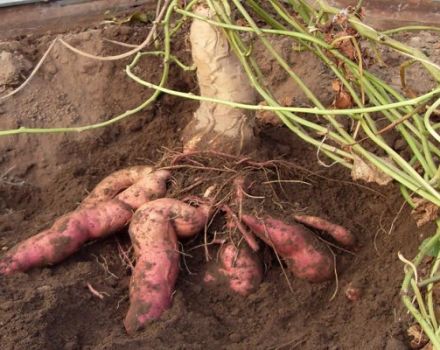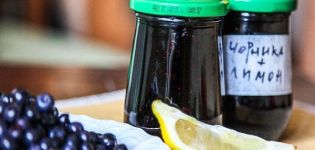Description and characteristics of Viksne currants, planting and care rules
Red currant is appreciated by Russian gardeners for its pleasant taste and the presence of useful trace elements. It contains a lot of vitamin elements. However, breeders do not develop new varieties of this berry very often. The newest variety known today is Viksne currant, bred in Latvia. Viksne currant can often be found in Russian gardens.
Variety selection
The variety was bred by Latvian breeders at the Ogre fruit and vegetable station, which is engaged in the creation of new types of berries. Researchers Zvyagina and Viksne took part in the selection. The variety was obtained from the seed material of the Varshevich variety, characterized by an unusual fruit color.
In 1997, Viksne was entered into the state register of the Russian Federation. It can be planted in the northwest of the Russian Federation and in the Black Earth Region.
Description of the hybrid
The berries can be red, light. The difference between them lies not only in color, but also in taste characteristics. Bushes with light berries do not belong to a separate subspecies. This is an ordinary albino.
Bushes
The branches of the bushes are spreading, have a height of 100 to 150 centimeters. The shoots are thick and brownish in color. The buds are small, oblong and slightly deviated from the shoot.
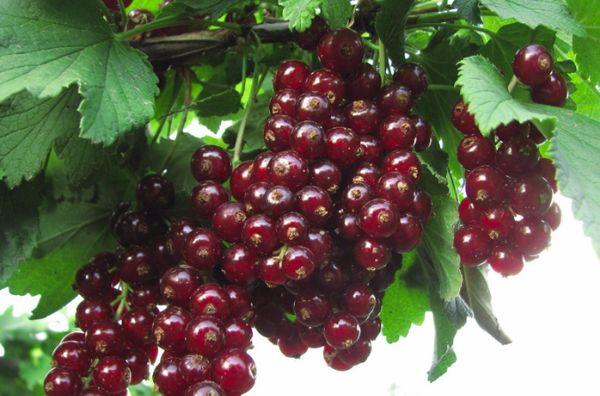
The leaves include 5 lobes, wavy edge, are greenish in color. The plate is straight, slightly pubescent in the lower part. The teeth are ordinary, obtuse, crenate type. The flowers are standard, reminiscent of a saucer of great depth. They are located on large racemes that grow up to 110-160 millimeters in length. Sepals are light, with stripes of lilac color.
Berries
The average fruit weight is 700-900 milligrams. They are round, slightly elongated, with noticeable veins. The berries smell good, stand out with a sour-sweet taste. Gardeners' assessment - 4 points. There are some seeds in the pulp. The skin is thin and has high strength.
If you plant the bushes in September, then by the summer season the fruits will be suitable for consumption. In late spring, flowering begins, and in the middle of summer, berries can be picked. Productivity - up to 10 kilograms of fruits from one bush. Usually, gardeners collect about 6 kilograms of berries from one bush.
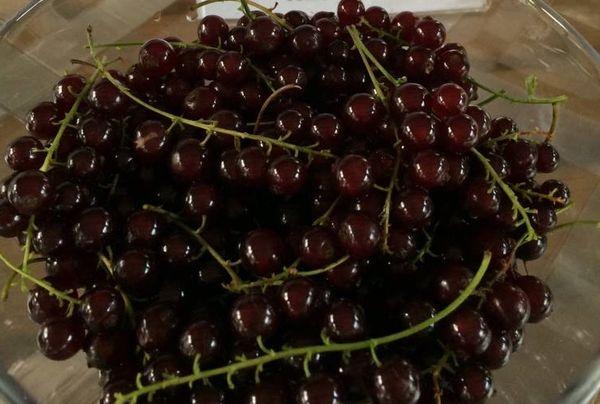
Advantages and disadvantages
Viksne has the following advantages:
- resistance to low temperature conditions. Bushes calmly tolerate cold even without shelter;
- resistance to arid conditions and temperature changes;
- good productivity;
- anthracnose resistance;
- pleasant taste;
- lack of tendency to shedding.
The cons of the variety are as follows:
- susceptibility to red gall aphids;
- reduced yield due to freezing of the buds;
- deterioration of taste characteristics if irrigation rules are not followed;
- the inability to store fruits for a long time.
Varietal features
Viksne is a medium early variety with a high yield. It is resistant to cold weather, common diseases and pests.
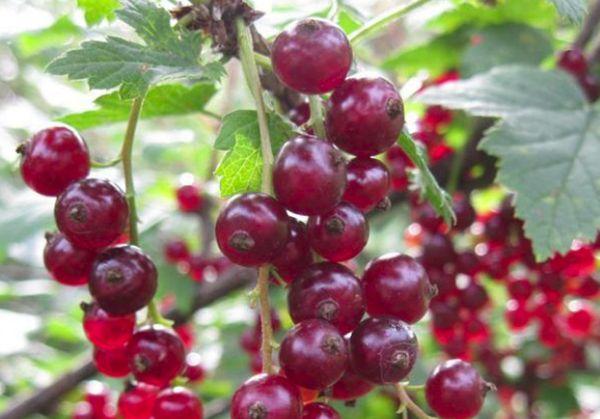
Cherry currant
Cherry currants are versatile. It can be eaten fresh, frozen and processed. Since fruits contain a lot of pectin, you can make jam and preserves from them. Dark red fruits are used to bring down fever and prevent inflammation.
White Viksne
Gardeners make homemade wine from light berries, which has an excellent taste. The juice from them quenches thirst, includes elements that contribute to the normalization of blood clotting. Also, the fruits are used to prevent heart attacks.
Characteristics of culture
Berry picking is performed with brushes. If you tear the fruit off the branches, the skin may deform. Currants can stay on the stalk for a long time without deteriorating their appearance and taste.
Susceptibility to diseases and pests
Viksne is resistant to most of the known diseases and pests, but is often affected by the red-gall aphid.
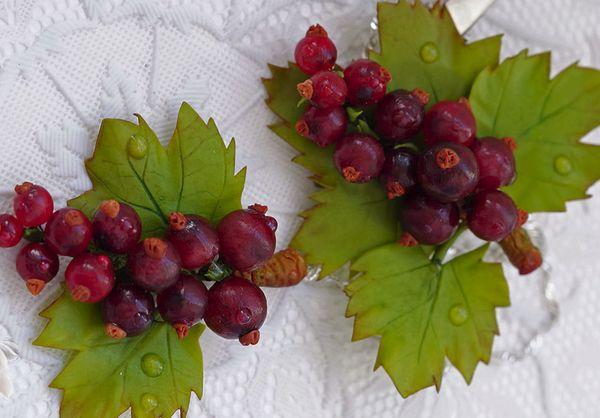
Resistant to low temperatures and drought
Currants tolerate dry weather normally (do not forget to follow the watering rules). Sudden cold weather will not do much harm to the bushes.
Ripening period and yield
The berries ripen in summer. From 1 hectare it is possible to get about 17 tons of berries. This is a pretty good indicator.
Transportability and use of berries
Viksne currant is not intended for long-term storage. Moreover, it is considered a transportable variety. The fruits can be used for making homemade dishes (jelly, mousse) and for medicinal purposes (prevention of cardiovascular diseases, lowering the temperature).
How to plant a variety on the site
If you follow the key agrotechnical standards when planting bushes and take good care of them, then you can harvest a large harvest of berries.
Terms of planting works
The best time to disembark is September. The margin of time before the arrival of severe cold weather should be 14-21 days. During this time, the plant will be able to take root. Ambient temperature during disembarkation should not be less than 6 degrees.
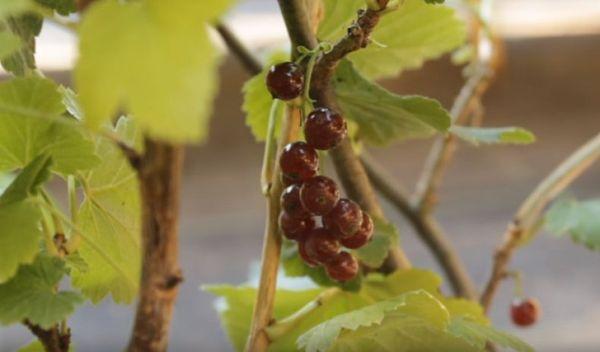
Selection and preparation of a seedling
Planting material must be purchased from reliable suppliers. Saplings should have normally developed roots, strong and lignified branches. Cracks may be present on the bark. In some places, peeling of the bark may be observed, this is normal.
Preparing the site
When choosing a place for planting currants, remember the following:
- the site must be open, have access to the rays of the sun and protection from cold winds. The plant can be grown in partial shade, however Viksne will never grow in full shade. The best option is planting near a hedge;
- the ground should be slightly moistened. Do not plant currants in wetlands. Groundwater should not be located closer than 0.8 meters to the surface;
- It is better to plant Viksne in light, sandy loam or loamy soil;
- the planting area should be free of irregularities.
Landing technology
Before you start rooting the planting material, inspect it, trim parts that are dry or damaged.

The landing algorithm is as follows:
- Digging trenches or pits with a depth and width of 400-450 millimeters.The distance between plants should be at least 150 centimeters. If you plant the bushes closer to each other, their growth will slow down.
- Fill the grooves 2 thirds with the prepared mixture. The mixture includes 1 part of humus, 2 parts of peat or compost, 0.25 kilograms of superphosphate, 60 grams of potassium supplements. You can add some wood ash.
- Watering the well with 5 liters of water.
- Spreading the roots of the planting material.
- Lowering the seedlings into the grooves at an inclination of 45 degrees.
- Filling the bushes with soil. Deepening the root collar is required by 60 millimeters.
- Light compaction of the soil near the bushes, abundant watering with water that has settled.
- Shortening shoots. On each of them, you need to leave a maximum of 4-5 buds (150-200 millimeters from the earth's surface).
The land near the plants needs to be mulched. This will prevent moisture from evaporating quickly.
Seasonal care basics
Although Viksne is an unpretentious variety to care for, it still needs to be looked after. It is required to follow the rules of irrigation, feeding and the formation of shrubs.
Regular watering
Watering the currants is required every 3-4 days. The bushes are especially in need of irrigation when they bear fruit and bloom. Water must be poured onto the trunk circle of bushes (2-3 buckets per plant).

Fertilizing bushes
Viksne is fertilized 2 times. Before the fruits begin to ripen (in the spring season or at the beginning of summer), fertilizing with nitrogen (urea, ammonium nitrate) is used. After flowering, the plants are fertilized with bird droppings, cow dung. In the autumn season, when the soil is dug up, fertilizing with potassium and phosphorus is used. Viksne is highly sensitive to chlorine elements, therefore it is better not to use fertilizers that contain chlorine.
Formative pruning
Mature shrubs do not need to be pruned constantly. However, every spring it is necessary to get rid of branches that are damaged or withered.
Protection from winter cold
Despite the fact that this type of currant is considered winter-hardy, young shrubs must be covered for the winter. In addition, mulching with hay or straw is required. If there is abundant precipitation in the winter season, you need to pour snow into the groove near the trunk and tamp it.
Reviews of gardeners about culture
Further you can find out what gardeners think about Viksna currant.
Tatiana, Moscow
“I have been growing Viksne for a long time for myself and for sale. I was attracted by the versatility and unpretentiousness of this type of currant. The fruits are large, strong, practically without seeds, and have a presentation. I grow bushes with cherry berries. Once a year, around the beginning of May, I spray the plants with a special aphid remedy. "
Victor, St. Petersburg
“2 years ago I purchased planting material for Viksne. I liked the color of the fruit and the excellent taste. Now I make delicious fruit drinks and juices every year. I collect about 6 kilograms of berries from each bush. Unfortunately, last year the shrubs began to bloom very early, which caused freezing. Not all of the hands were tied, so I didn’t collect as many fruits as I would like. ”
Viksne currant contains a large amount of vitamins and other microelements. If you organize the fertilization and care of shrubs correctly, you can regularly collect large crops.
